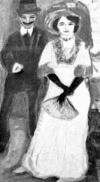- Brücke, Die
-
(German; "The Bridge")Organization of German Expressionist artists.It was founded in 1905 by four architectural students at the Dresden Technical School, including Ernst Ludwig Kirchner and Karl Schmidt-Rottluff, who were soon joined by other German and European artists. Its name reflects their hope that their work would be a bridge to the art of the future. Strongly influenced by primitive art, German Gothic woodcuts, and the prints of Edvard Munch, they produced figure paintings and portraits depicting human suffering and anxiety, as well as still lifes and landscapes characterized by harshly distorted shapes and violent colours. They contributed to the 20th-century revival of the woodcut. The group disbanded in 1913.
 "Dodo and Her Brother," oil painting by Die Brücke artist Ernst Ludwig Kirchner, ...Courtesy of the Smith College Museum of Art, Northampton, Mass.
"Dodo and Her Brother," oil painting by Die Brücke artist Ernst Ludwig Kirchner, ...Courtesy of the Smith College Museum of Art, Northampton, Mass.* * *
▪ art organizationGerman“The Bridge”organization of German painters and printmakers that from 1905 to 1913 played a pivotal role in the development of Expressionism.The group was founded in 1905 in Germany by four architectural students in Dresden—Karl Schmidt-Rottluff (Schmidt-Rottluff, Karl), who gave the group its name, Fritz Bleyl, Erich Heckel (Heckel, Erich), and Ernst Ludwig Kirchner (Kirchner, Ernst Ludwig). Other artists joined the organization over the next several years, including Emil Nolde (Nolde, Emil), Max Pechstein (Pechstein, Max), Otto Müller, the Swiss artist Cuno Amiet, the Finnish artist Akseli Gallén-Kallela, and the Dutch Fauvist painter Kees van Dongen (Dongen, Kees van). These young artists formed an idealistic, communal atmosphere in which they shared techniques and exhibited together.From their first manifesto, written by Kirchner in 1905, Die Brücke sought to create an authentic art that defied the conventions of traditional painting as well as the then-dominant schools of Impressionism and Post-Impressionism. The paintings and prints by Die Brücke artists encompassed all varieties of subject matter—the human figure, landscape, portraiture, still life—executed in a simplified style that stressed bold outlines and strong colour planes. Like many avant-garde artists at the time, Kirchner and Heckel admired the apparent lack of artifice in art from places such as Africa and the Pacific islands and emulated this supposedly “primitive” quality in their own work. Similar qualities were being explored at the same time by the French Fauve (Fauvism) artists, yet manifestations of angst, or anxiety, appear in varying degrees in the works of Die Brücke painters and generally distinguish their art from Fauvist art, which treats form and colour in a more lyrical manner. Die Brücke art was also deeply influenced by the expressive simplifications of late German Gothic woodcuts (woodcut) and by the prints of the Norwegian artist Edvard Munch (Munch, Edvard). The movement contributed to the revival of the woodcut, making it a powerful means of expression in the 20th century.The first Die Brücke exhibition, held in 1906 in the Seifert lamp factory in Dresden, marked the beginning of German Expressionism. From this date until 1913, regular exhibitions were held. (By 1911, however, Die Brücke's activities had shifted to Berlin, where several of the members were living.) The group also enlisted “honorary members” to whom they issued annual reports and gift portfolios of original prints, which are highly valued collector's items today.There were already volatile relationships among the artists, but these rifts increased in the years after 1911. In 1913, provoked by Kirchner's highly subjective accounts of their activities in the Chronik der Künstlergemeinschaft Brücke, the group disbanded.* * *
Universalium. 2010.
